Using a “black box” likelihood function (numpy)¶
Note
This notebook in part of a set of two twin notebooks that perform the exact same task, this one uses numpy whereas this other one uses Cython
import arviz as az
import IPython
import matplotlib
import matplotlib.pyplot as plt
import numpy as np
import pymc3 as pm
import theano
import theano.tensor as tt
print(f"Running on PyMC3 v{pm.__version__}")
Running on PyMC3 v3.11.4
%config InlineBackend.figure_format = 'retina'
az.style.use("arviz-darkgrid")
Introduction¶
PyMC3 is a great tool for doing Bayesian inference and parameter estimation. It has a load of in-built probability distributions that you can use to set up priors and likelihood functions for your particular model. You can even create your own custom distributions.
However, this is not necessarily that simple if you have a model function, or probability distribution, that, for example, relies on an external code that you have little/no control over (and may even be, for example, wrapped C code rather than Python). This can be problematic when you need to pass parameters as PyMC3 distributions to these external functions; your external function probably wants you to pass it floating point numbers rather than PyMC3 distributions!
import pymc3 as pm
from external_module import my_external_func # your external function!
# set up your model
with pm.Model():
# your external function takes two parameters, a and b, with Uniform priors
a = pm.Uniform('a', lower=0., upper=1.)
b = pm.Uniform('b', lower=0., upper=1.)
m = my_external_func(a, b) # <--- this is not going to work!
Another issue is that if you want to be able to use the gradient-based step samplers like pymc.NUTS and Hamiltonian Monte Carlo (HMC), then your model/likelihood needs a gradient to be defined. If you have a model that is defined as a set of Theano operators then this is no problem - internally it will be able to do automatic differentiation - but if your model is essentially a “black box” then you won’t necessarily know what the gradients are.
Defining a model/likelihood that PyMC3 can use and that calls your “black box” function is possible, but it relies on creating a custom Theano Op. This is, hopefully, a clear description of how to do this, including one way of writing a gradient function that could be generally applicable.
In the examples below, we create a very simple model and log-likelihood function in numpy.
def my_model(theta, x):
m, c = theta
return m * x + c
def my_loglike(theta, x, data, sigma):
model = my_model(theta, x)
return -(0.5 / sigma ** 2) * np.sum((data - model) ** 2)
Now, as things are, if we wanted to sample from this log-likelihood function, using certain prior distributions for the model parameters (gradient and y-intercept) using PyMC3, we might try something like this (using a pymc.DensityDist or pymc.Potential):
import pymc3 as pm
# create/read in our "data" (I'll show this in the real example below)
x = ...
sigma = ...
data = ...
with pm.Model():
# set priors on model gradient and y-intercept
m = pm.Uniform('m', lower=-10., upper=10.)
c = pm.Uniform('c', lower=-10., upper=10.)
# create custom distribution
pm.DensityDist('likelihood', my_loglike,
observed={'theta': (m, c), 'x': x, 'data': data, 'sigma': sigma})
# sample from the distribution
trace = pm.sample(1000)
But, this will give an error like:
ValueError: setting an array element with a sequence.
This is because m and c are Theano tensor-type objects.
So, what we actually need to do is create a Theano Op. This will be a new class that wraps our log-likelihood function (or just our model function, if that is all that is required) into something that can take in Theano tensor objects, but internally can cast them as floating point values that can be passed to our log-likelihood function. We will do this below, initially without defining a grad() method for the Op.
Theano Op without grad¶
# define a theano Op for our likelihood function
class LogLike(tt.Op):
"""
Specify what type of object will be passed and returned to the Op when it is
called. In our case we will be passing it a vector of values (the parameters
that define our model) and returning a single "scalar" value (the
log-likelihood)
"""
itypes = [tt.dvector] # expects a vector of parameter values when called
otypes = [tt.dscalar] # outputs a single scalar value (the log likelihood)
def __init__(self, loglike, data, x, sigma):
"""
Initialise the Op with various things that our log-likelihood function
requires. Below are the things that are needed in this particular
example.
Parameters
----------
loglike:
The log-likelihood (or whatever) function we've defined
data:
The "observed" data that our log-likelihood function takes in
x:
The dependent variable (aka 'x') that our model requires
sigma:
The noise standard deviation that our function requires.
"""
# add inputs as class attributes
self.likelihood = loglike
self.data = data
self.x = x
self.sigma = sigma
def perform(self, node, inputs, outputs):
# the method that is used when calling the Op
(theta,) = inputs # this will contain my variables
# call the log-likelihood function
logl = self.likelihood(theta, self.x, self.data, self.sigma)
outputs[0][0] = np.array(logl) # output the log-likelihood
Now, let’s use this Op to repeat the example shown above. To do this let’s create some data containing a straight line with additive Gaussian noise (with a mean of zero and a standard deviation of sigma). For simplicity we set Uniform prior distributions on the gradient and y-intercept. As we’ve not set the grad() method of the Op PyMC3 will not be able to use the gradient-based samplers, so will fall back to using the pymc.Slice sampler.
# set up our data
N = 10 # number of data points
sigma = 1.0 # standard deviation of noise
x = np.linspace(0.0, 9.0, N)
mtrue = 0.4 # true gradient
ctrue = 3.0 # true y-intercept
truemodel = my_model([mtrue, ctrue], x)
# make data
rng = np.random.default_rng(716743)
data = sigma * rng.normal(size=N) + truemodel
# create our Op
logl = LogLike(my_loglike, data, x, sigma)
# use PyMC3 to sampler from log-likelihood
with pm.Model():
# uniform priors on m and c
m = pm.Uniform("m", lower=-10.0, upper=10.0)
c = pm.Uniform("c", lower=-10.0, upper=10.0)
# convert m and c to a tensor vector
theta = tt.as_tensor_variable([m, c])
# use a Potential to "call" the Op and include it in the logp computation
pm.Potential("likelihood", logl(theta))
# Use custom number of draws to replace the HMC based defaults
idata_mh = pm.sample(3000, tune=1000, return_inferencedata=True)
# plot the traces
az.plot_trace(idata_mh, lines=[("m", {}, mtrue), ("c", {}, ctrue)]);
Auto-assigning NUTS sampler...
Initializing NUTS using jitter+adapt_diag...
Initializing NUTS failed. Falling back to elementwise auto-assignment.
Multiprocess sampling (4 chains in 4 jobs)
CompoundStep
>Slice: [c]
>Slice: [m]
Sampling 4 chains for 1_000 tune and 3_000 draw iterations (4_000 + 12_000 draws total) took 14 seconds.
The number of effective samples is smaller than 25% for some parameters.
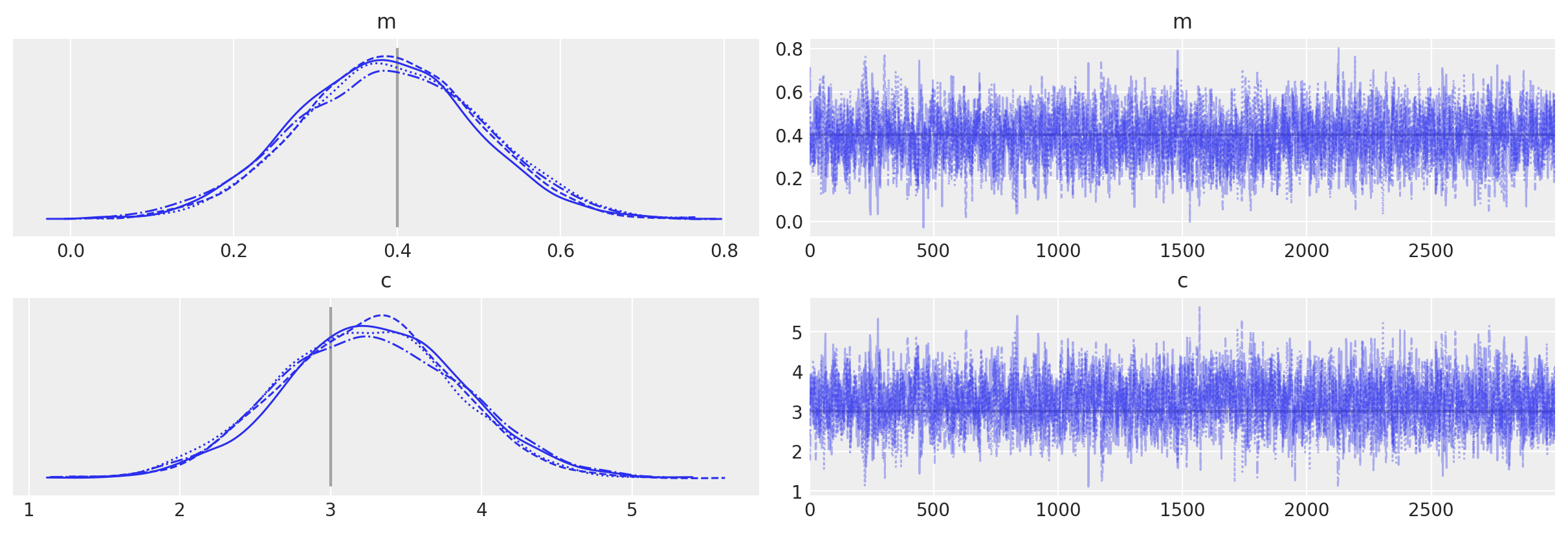
Theano Op with grad¶
What if we wanted to use NUTS or HMC? If we knew the analytical derivatives of the model/likelihood function then we could add a grad() method to the Op using that analytical form.
But, what if we don’t know the analytical form. If our model/likelihood is purely Python and made up of standard maths operators and Numpy functions, then the autograd module could potentially be used to find gradients (also, see here for a nice Python example of automatic differentiation). But, if our model/likelihood truely is a “black box” then we can just use the good-old-fashioned finite difference to find the gradients - this can be slow, especially if there are a large number of variables, or the model takes a long time to evaluate. Below, a function to find gradients has been defined that uses the finite difference (the central difference) - it uses an iterative method with successively smaller interval sizes to check that the gradient converges. But, you could do something far simpler and just use, for example, the SciPy approx_fprime function.
Note that since PyMC3 3.11.0, normalization constants are dropped from the computation, thus, we will do the same to ensure both gradients return exactly the same value (which will be checked below). As sigma=1 in this case the dropped factor is only a factor 2, but for completeness, the term is shown as a comment. Try to see what happens if you uncomment this term and rerun the whole notebook.
def normal_gradients(theta, x, data, sigma):
"""
Calculate the partial derivatives of a function at a set of values. The
derivatives are calculated using the central difference, using an iterative
method to check that the values converge as step size decreases.
Parameters
----------
theta: array_like
A set of values, that are passed to a function, at which to calculate
the gradient of that function
x, data, sigma:
Observed variables as we have been using so far
Returns
-------
grads: array_like
An array of gradients for each non-fixed value.
"""
grads = np.empty(2)
aux_vect = data - my_model(theta, x) # /(2*sigma**2)
grads[0] = np.sum(aux_vect * x)
grads[1] = np.sum(aux_vect)
return grads
So, now we can just redefine our Op with a grad() method, right?
It’s not quite so simple! The grad() method itself requires that its inputs are Theano tensor variables, whereas our gradients function above, like our my_loglike function, wants a list of floating point values. So, we need to define another Op that calculates the gradients. Below, I define a new version of the LogLike Op, called LogLikeWithGrad this time, that has a grad() method. This is followed by anothor Op called LogLikeGrad that, when called with a vector of Theano tensor variables, returns another vector of values that are the gradients (i.e., the Jacobian) of our log-likelihood function at those values. Note that the grad() method itself does not return the gradients directly, but instead returns the Jacobian-vector product (you can hopefully just copy what I’ve done and not worry about what this means too much!).
# define a theano Op for our likelihood function
class LogLikeWithGrad(tt.Op):
itypes = [tt.dvector] # expects a vector of parameter values when called
otypes = [tt.dscalar] # outputs a single scalar value (the log likelihood)
def __init__(self, loglike, data, x, sigma):
"""
Initialise with various things that the function requires. Below
are the things that are needed in this particular example.
Parameters
----------
loglike:
The log-likelihood (or whatever) function we've defined
data:
The "observed" data that our log-likelihood function takes in
x:
The dependent variable (aka 'x') that our model requires
sigma:
The noise standard deviation that out function requires.
"""
# add inputs as class attributes
self.likelihood = loglike
self.data = data
self.x = x
self.sigma = sigma
# initialise the gradient Op (below)
self.logpgrad = LogLikeGrad(self.data, self.x, self.sigma)
def perform(self, node, inputs, outputs):
# the method that is used when calling the Op
(theta,) = inputs # this will contain my variables
# call the log-likelihood function
logl = self.likelihood(theta, self.x, self.data, self.sigma)
outputs[0][0] = np.array(logl) # output the log-likelihood
def grad(self, inputs, g):
# the method that calculates the gradients - it actually returns the
# vector-Jacobian product - g[0] is a vector of parameter values
(theta,) = inputs # our parameters
return [g[0] * self.logpgrad(theta)]
class LogLikeGrad(tt.Op):
"""
This Op will be called with a vector of values and also return a vector of
values - the gradients in each dimension.
"""
itypes = [tt.dvector]
otypes = [tt.dvector]
def __init__(self, data, x, sigma):
"""
Initialise with various things that the function requires. Below
are the things that are needed in this particular example.
Parameters
----------
data:
The "observed" data that our log-likelihood function takes in
x:
The dependent variable (aka 'x') that our model requires
sigma:
The noise standard deviation that out function requires.
"""
# add inputs as class attributes
self.data = data
self.x = x
self.sigma = sigma
def perform(self, node, inputs, outputs):
(theta,) = inputs
# calculate gradients
grads = normal_gradients(theta, self.x, self.data, self.sigma)
outputs[0][0] = grads
Now, let’s re-run PyMC3 with our new “grad”-ed Op. This time it will be able to automatically use NUTS.
# create our Op
logl = LogLikeWithGrad(my_loglike, data, x, sigma)
# use PyMC3 to sampler from log-likelihood
with pm.Model() as opmodel:
# uniform priors on m and c
m = pm.Uniform("m", lower=-10.0, upper=10.0)
c = pm.Uniform("c", lower=-10.0, upper=10.0)
# convert m and c to a tensor vector
theta = tt.as_tensor_variable([m, c])
# use a Potential
pm.Potential("likelihood", logl(theta))
idata_grad = pm.sample(return_inferencedata=True)
# plot the traces
_ = az.plot_trace(idata_grad, lines=[("m", {}, mtrue), ("c", {}, ctrue)])
Auto-assigning NUTS sampler...
Initializing NUTS using jitter+adapt_diag...
Multiprocess sampling (4 chains in 4 jobs)
NUTS: [c, m]
Sampling 4 chains for 1_000 tune and 1_000 draw iterations (4_000 + 4_000 draws total) took 8 seconds.
The acceptance probability does not match the target. It is 0.886120911040209, but should be close to 0.8. Try to increase the number of tuning steps.
The number of effective samples is smaller than 25% for some parameters.
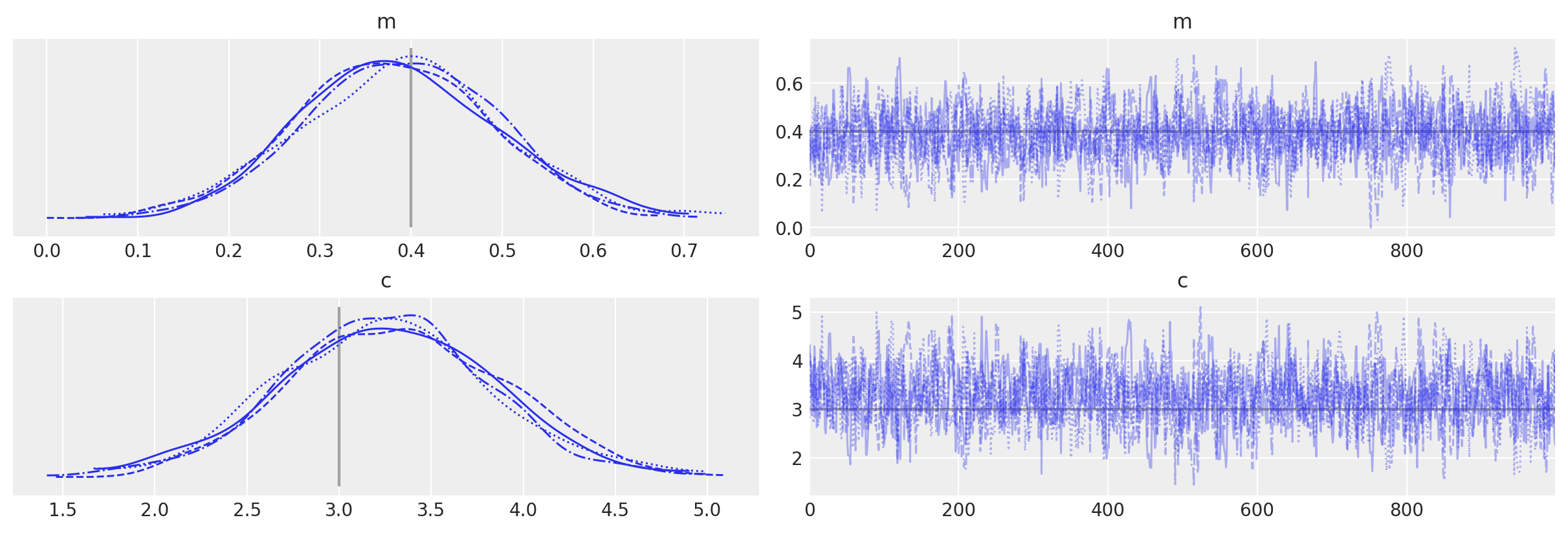
Comparison to equivalent PyMC distributions¶
Now, finally, just to check things actually worked as we might expect, let’s do the same thing purely using PyMC3 distributions (because in this simple example we can!)
with pm.Model() as pymodel:
# uniform priors on m and c
m = pm.Uniform("m", lower=-10.0, upper=10.0)
c = pm.Uniform("c", lower=-10.0, upper=10.0)
# convert m and c to a tensor vector
theta = tt.as_tensor_variable([m, c])
# use a Normal distribution
pm.Normal("likelihood", mu=(m * x + c), sd=sigma, observed=data)
idata = pm.sample(return_inferencedata=True)
# plot the traces
az.plot_trace(idata, lines=[("m", {}, mtrue), ("c", {}, ctrue)]);
Auto-assigning NUTS sampler...
Initializing NUTS using jitter+adapt_diag...
Multiprocess sampling (4 chains in 4 jobs)
NUTS: [c, m]
Sampling 4 chains for 1_000 tune and 1_000 draw iterations (4_000 + 4_000 draws total) took 6 seconds.
The number of effective samples is smaller than 25% for some parameters.
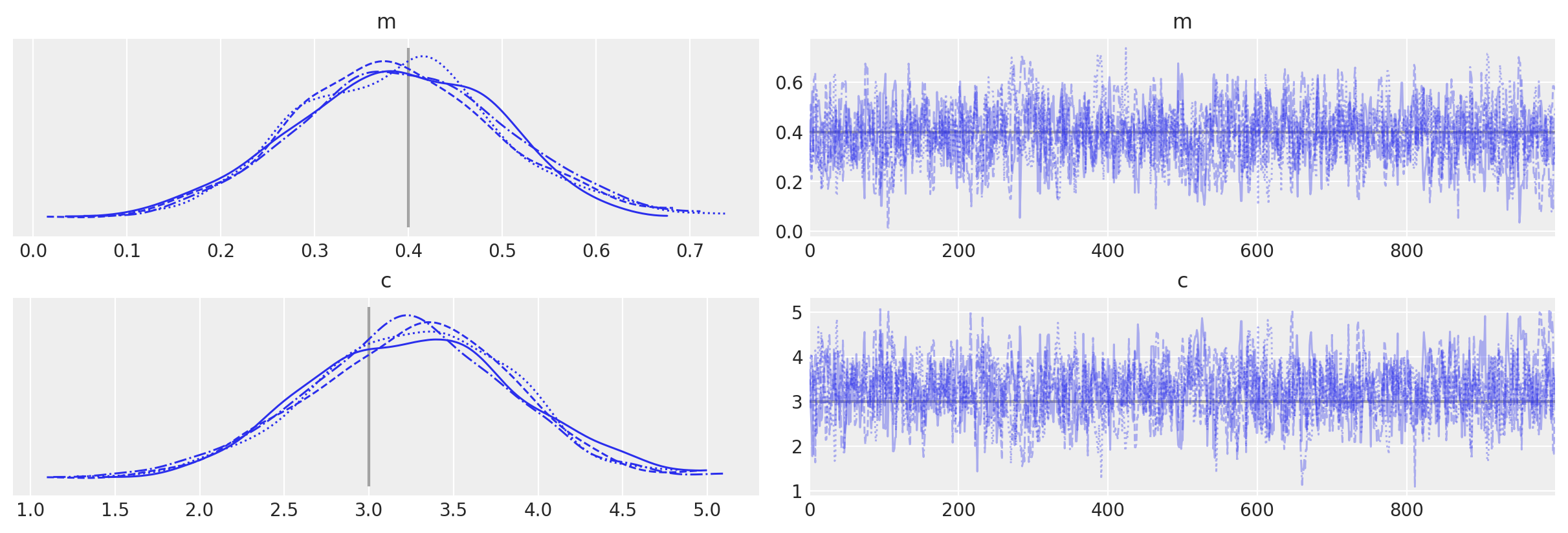
To check that they match let’s plot all the examples together and also find the autocorrelation lengths.
_, axes = plt.subplots(3, 2, sharex=True, sharey=True)
az.plot_autocorr(idata_mh, combined=True, ax=axes[0, :])
az.plot_autocorr(idata_grad, combined=True, ax=axes[1, :])
az.plot_autocorr(idata, combined=True, ax=axes[2, :])
axes[2, 0].set_xlim(right=40);
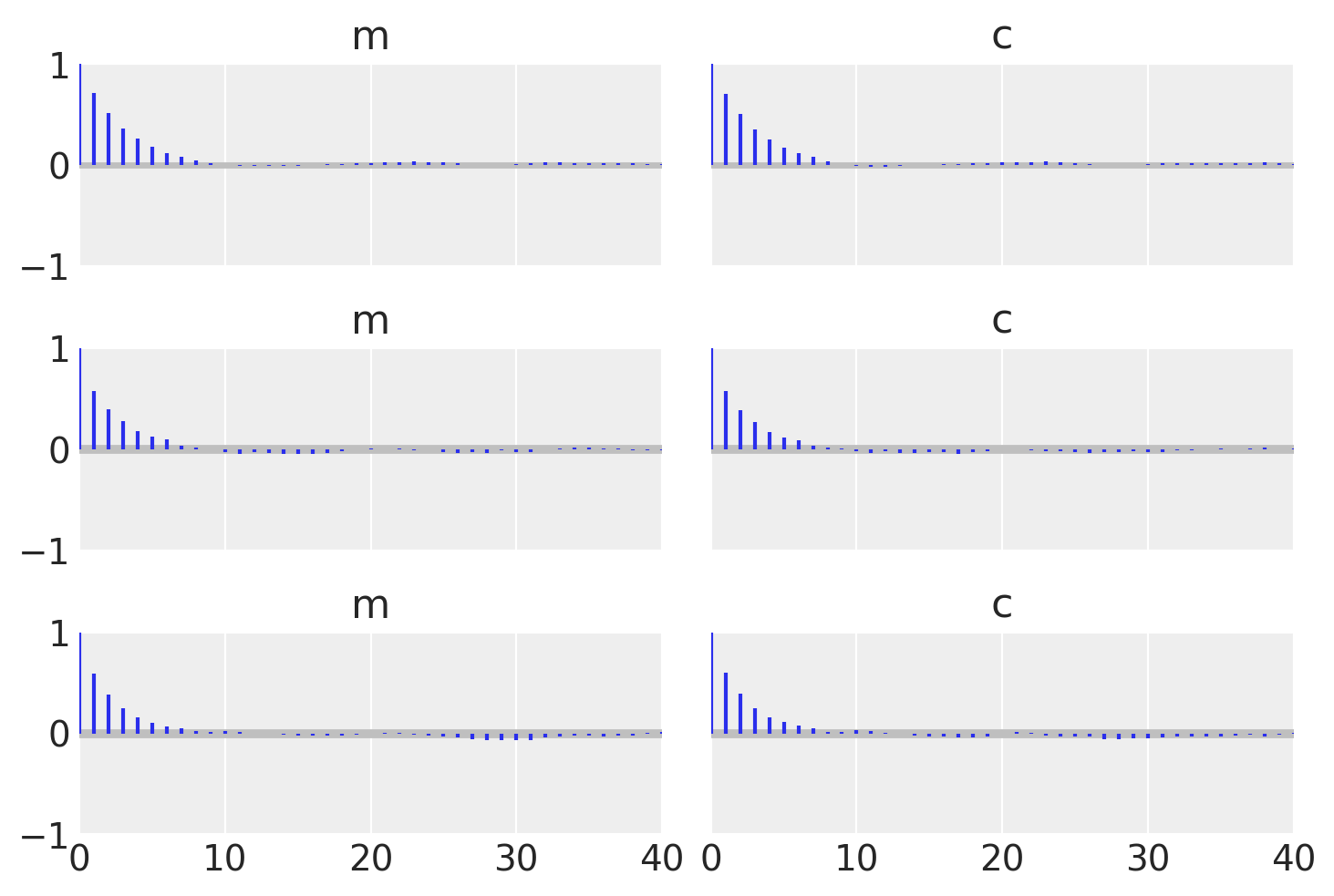
# Plot MH result (blue)
pair_kwargs = dict(
kind="kde",
marginals=True,
reference_values={"m": mtrue, "c": ctrue},
kde_kwargs={"contourf_kwargs": {"alpha": 0}, "contour_kwargs": {"colors": "C0"}},
reference_values_kwargs={"color": "k", "ms": 15, "marker": "d"},
marginal_kwargs={"color": "C0"},
)
ax = az.plot_pair(idata_mh, **pair_kwargs)
# Plot nuts+blackbox fit (orange)
pair_kwargs["kde_kwargs"]["contour_kwargs"]["colors"] = "C1"
pair_kwargs["marginal_kwargs"]["color"] = "C1"
az.plot_pair(idata_grad, **pair_kwargs, ax=ax)
# Plot pure pymc+nuts fit (green)
pair_kwargs["kde_kwargs"]["contour_kwargs"]["colors"] = "C2"
pair_kwargs["marginal_kwargs"]["color"] = "C2"
az.plot_pair(idata, **pair_kwargs, ax=ax);
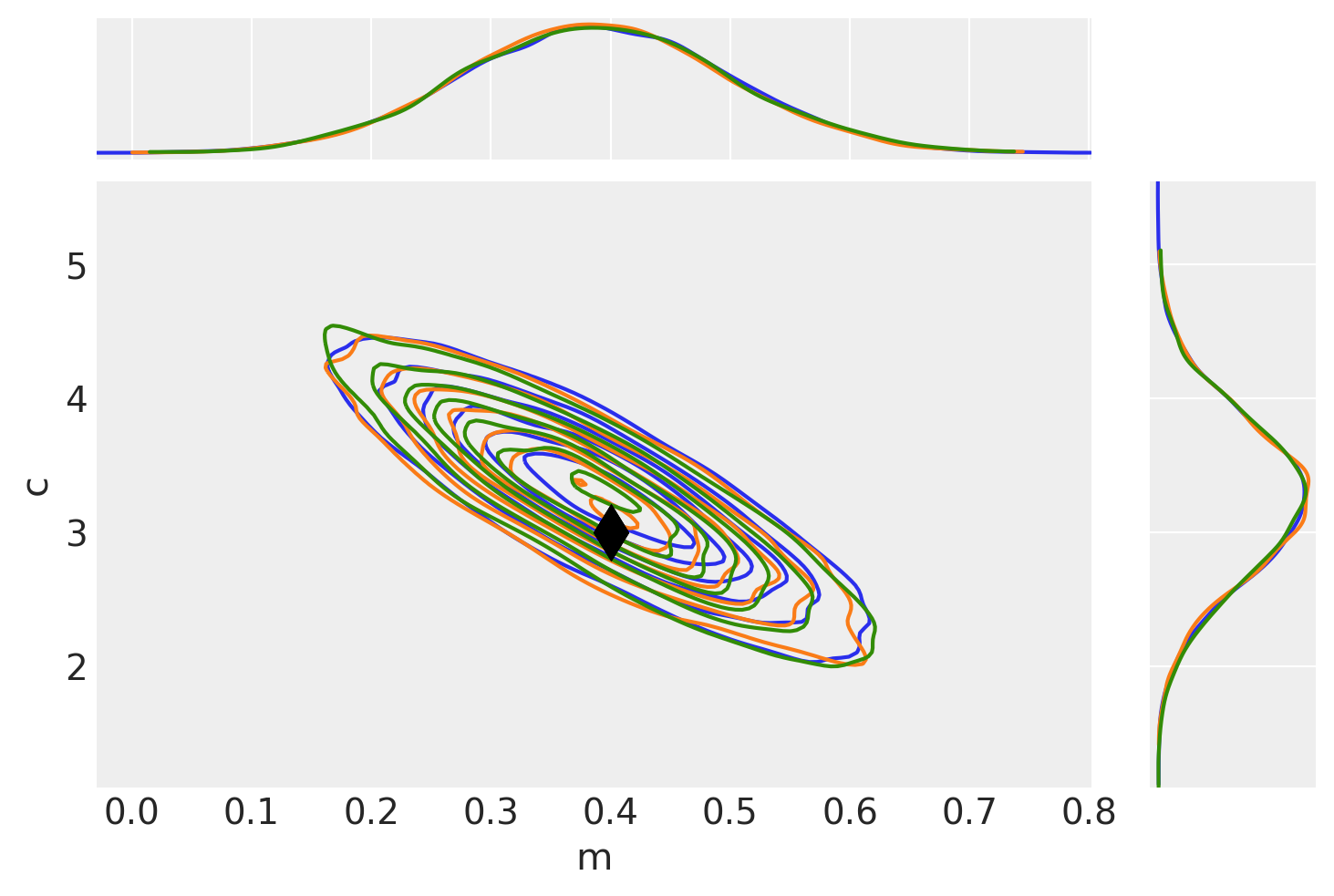
We can now check that the gradient Op works as expected. First, just create and call the LogLikeGrad class, which should return the gradient directly (note that we have to create a Theano function to convert the output of the Op to an array). Secondly, we call the gradient from LogLikeWithGrad by using the Theano tensor gradient function. Finally, we will check the gradient returned by the PyMC3 model for a Normal distribution, which should be the same as the log-likelihood function we defined. In all cases we evaluate the gradients at the true values of the model function (the straight line) that was created.
# test the gradient Op by direct call
theano.config.compute_test_value = "ignore"
theano.config.exception_verbosity = "high"
var = tt.dvector()
test_grad_op = LogLikeGrad(data, x, sigma)
test_grad_op_func = theano.function([var], test_grad_op(var))
grad_vals = test_grad_op_func([mtrue, ctrue])
print(f'Gradient returned by "LogLikeGrad": {grad_vals}')
# test the gradient called through LogLikeWithGrad
test_gradded_op = LogLikeWithGrad(my_loglike, data, x, sigma)
test_gradded_op_grad = tt.grad(test_gradded_op(var), var)
test_gradded_op_grad_func = theano.function([var], test_gradded_op_grad)
grad_vals_2 = test_gradded_op_grad_func([mtrue, ctrue])
print(f'Gradient returned by "LogLikeWithGrad": {grad_vals_2}')
# test the gradient that PyMC3 uses for the Normal log likelihood
test_model = pm.Model()
with test_model:
m = pm.Uniform("m", lower=-10.0, upper=10.0)
c = pm.Uniform("c", lower=-10.0, upper=10.0)
pm.Normal("likelihood", mu=(m * x + c), sigma=sigma, observed=data)
gradfunc = test_model.logp_dlogp_function([m, c], dtype=None)
gradfunc.set_extra_values({"m_interval__": mtrue, "c_interval__": ctrue})
grad_vals_pymc3 = gradfunc(np.array([mtrue, ctrue]))[1] # get dlogp values
print(f'Gradient returned by PyMC3 "Normal" distribution: {grad_vals_pymc3}')
Gradient returned by "LogLikeGrad": [8.32628482 2.02949635]
Gradient returned by "LogLikeWithGrad": [8.32628482 2.02949635]
Gradient returned by PyMC3 "Normal" distribution: [8.32628482 2.02949635]
We could also do some profiling to compare performace between implementations. The Profiling notebook shows how to do it.
Watermark¶
%load_ext watermark
%watermark -n -u -v -iv -w -p xarray
Last updated: Sun Dec 19 2021
Python implementation: CPython
Python version : 3.9.7
IPython version : 7.29.0
xarray: 0.20.1
arviz : 0.11.4
theano : 1.1.2
IPython : 7.29.0
matplotlib: 3.4.3
numpy : 1.21.4
pymc3 : 3.11.4
Watermark: 2.2.0
License notice¶
All the notebooks in this example gallery are provided under the MIT License which allows modification, and redistribution for any use provided the copyright and license notices are preserved.
Citing PyMC examples¶
To cite this notebook, use the DOI provided by Zenodo for the pymc-examples repository.
Important
Many notebooks are adapted from other sources: blogs, books… In such cases you should cite the original source as well.
Also remember to cite the relevant libraries used by your code.
Here is an citation template in bibtex:
@incollection{citekey,
author = "<notebook authors, see above>"
title = "<notebook title>",
editor = "PyMC Team",
booktitle = "PyMC examples",
doi = "10.5281/zenodo.5832070"
}
which once rendered could look like:
- Matt Pitkin , Jørgen Midtbø , Oriol Abril . "Using a “black box” likelihood function (numpy)". In: PyMC Examples. Ed. by PyMC Team. DOI: 10.5281/zenodo.5832070